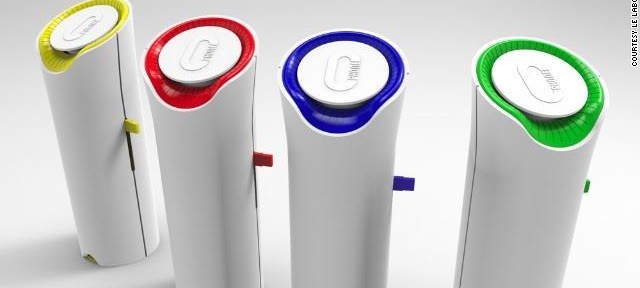Consumers’ near-obsession with digital communication has fueled creativity within IT developers. Part of a new generation of sensory engineers, Dr. David Edwards, is a biomedical engineer at Harvard and founder of Le Laboratoire. He is one of many who are going beyond the senses of sight and sound to provide a new set of experiences for telecommunication buyers. His project: a phone that lets you send smells. (Tweet this quote.)
“Our motto is ‘aroma tells a thousand pictures,” says Dr. Edwards. “Biologically we respond powerfully to aroma, so if we become familiar with the design of aromatic communication we might be able to say things we couldn’t before.”
According to an article in CNN Tech:
A free app will allow anyone to compose and send a smell note by text or email, based on a set menu of aromas and variations. The message can be received by any normal phone as a text. The recipient can then download the composition from hotspots which will be set up in the launch city of Boston.
This technology can, and probably will, drastically change the way people connect, engage, and share experiences. Here are some points that marketers should be taking into consideration as aromatic communication becomes a reality. (Tweet this quote.)
How will aroma messaging change digital marketing?
The biggest change in digital marketing due to aromatic communications will be a shift in how we interact. Most of us only use two senses–sight and sound–to communicate. But now we’ll be thinking of what a smell, or a combination of smells, means.
Edwards’ goal is to exploit the emotional phenomenon smell initiates in humans. A whiff of chocolate chip cookies can remind us of childhood. The scent of chlorine reminds us of summer. In the same way, marketers can use smell to establish a new connection with its buyers. Just as we associate logos, colors, and symbols with particular brands, marketers will now be able to do the same with smells.
Marketers can also expect a surge of new technological advancements. If Edwards’ oPhone proves to be successful, a variety of competitive and complementary devices will be developed. Marketers can get excited about the possibility of new marketing technology–one that lets us send smell notes, or oNotes, to our audience through digital devices.
How will aroma be used to communicate with buyers?
People have long been restricted to sight and sound for communication. That’s why Edwards is “expecting an interest in self-expression.”
Aroma as communication is new to our society, which means there is a lot of room for experimentation. Ideas, concepts, and feelings that have been virtually impossible to convey might now be possible.
Using smell to market a product may be much simpler, at least in theory, for some companies. A travel agency looking to book Caribbean cruises might send oceanic aromas. Restaurants might send smells of items from its menu.
But what about companies that sell IT? I’m not sure tech buyers would be driven to make a purchase from an email smelling like gold or copper. What about service providers? How do you promote an intangible service by using smell?
Fortunately, marketers are becoming experts in communication. It’s essential not only to our success, but our professional survival. As Dr. Edwards quotes, we will have to “learn with the public.” This type of technology will challenge our understanding of language. Marketing products and services through smell will help us better understand how a brand’s identity is established in the minds of its buyers. (Tweet this quote.)
How will the effectiveness of aroma messaging be measured?
Because recipients of aromatic messages don’t have to be oPhone owners, organizations will be able to send smell-good messages to anyone with a mobile device.
Marketers may not have to alter much of their digital measurement plan to analyze the effectiveness of aroma marketing. Measuring smell notes will be similar to tracking open and click rates for regular email and text messages. Marketers will test the frequency and content of sent messages. Just as we A/B test the copy within a text email, we will also test the aromatic variations of the smell notes that are sent to contact lists.
We might see an initial effect on open rates if a recipient cannot access the smell note directly from the email or text message, but instead must take another action to download the note. Some people may not mind the extra step to receive a smell note, especially if the message is from a friend or loved one. But companies that haven’t established strong loyalty with its customers may have a little more difficulty in prompting such action.
Will a new marketing technology be launched?
Will this new phone that lets you send smells launch a new marketing technology? Absolutely. That is if aromatic communication is accepted into society. My bets are that it will be.
Research has indicated that the best way to communicate with potential buyers is to use the same IT used for social, personal, and work-related reasons. This is why most digital marketers are early adopters of technology.
All-in-one marketing software companies should begin considering how to integrate with the aromatic technology. A demand for platforms devoted solely to the automation and measurement of aroma messaging could also rise.
Edwards’ vision includes adding aromatic technology to books, movies, and other digitalized media. This means that companies such as Google, Facebook, Instagram, and Pinterest (to name a few) might also want to collaborate with Edwards to integrate smell into their platforms. This would allow anyone to add an extra dimension to their profiles. For instance, if I were to take a trip to Italy and share the pictures through social media, I would also be able to tag pictures and status updates with aroma. My friends and followers would not only be able to see and hear what I’m doing, but smell the foods, flowers, and oceans with which I interact.
What is the next step for digital marketers?
Start thinking of how your products and services smell. That’s right–how they smell. Or better yet, how the solution your services provide smells.
This is where marketers will become creative in expanding a brand’s message beyond written or spoken words. Market research should be conducted to understand how buyers associate a solution with smell. How do you express security, stability, or innovation through aroma? Answers will vary. Marketers may even use psychological conditioning to help people associate smells with a particular brand, service, or product.
People love to express themselves. We’ve seen it before with blogging websites and social media. Marketers can expect to keep adopting technologies that provide new and innovational ways of communicating.
Don’t let it be a surprise when a new technology like the oPhone finds its way into a marketing plan. (Tweet this quote.)
If you want to learn more about the first oPhone, DUO, set to launch summer of 2014, make sure to visit the website.
Keep watch for the next post: 5 Tips for Building a Startup Marketing Plan




